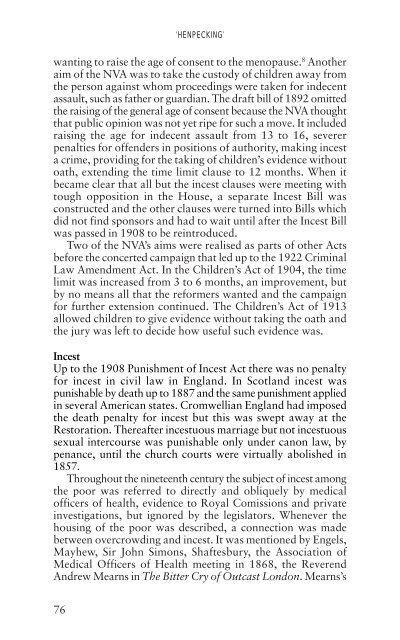The Spinster and Her Enemies - Feminish
The Spinster and Her Enemies - Feminish
The Spinster and Her Enemies - Feminish
Create successful ePaper yourself
Turn your PDF publications into a flip-book with our unique Google optimized e-Paper software.
‘HENPECKING’<br />
wanting to raise the age of consent to the menopause. 8 Another<br />
aim of the NVA was to take the custody of children away from<br />
the person against whom proceedings were taken for indecent<br />
assault, such as father or guardian. <strong>The</strong> draft bill of 1892 omitted<br />
the raising of the general age of consent because the NVA thought<br />
that public opinion was not yet ripe for such a move. It included<br />
raising the age for indecent assault from 13 to 16, severer<br />
penalties for offenders in positions of authority, making incest<br />
a crime, providing for the taking of children’s evidence without<br />
oath, extending the time limit clause to 12 months. When it<br />
became clear that all but the incest clauses were meeting with<br />
tough opposition in the House, a separate Incest Bill was<br />
constructed <strong>and</strong> the other clauses were turned into Bills which<br />
did not find sponsors <strong>and</strong> had to wait until after the Incest Bill<br />
was passed in 1908 to be reintroduced.<br />
Two of the NVA’s aims were realised as parts of other Acts<br />
before the concerted campaign that led up to the 1922 Criminal<br />
Law Amendment Act. In the Children’s Act of 1904, the time<br />
limit was increased from 3 to 6 months, an improvement, but<br />
by no means all that the reformers wanted <strong>and</strong> the campaign<br />
for further extension continued. <strong>The</strong> Children’s Act of 1913<br />
allowed children to give evidence without taking the oath <strong>and</strong><br />
the jury was left to decide how useful such evidence was.<br />
Incest<br />
Up to the 1908 Punishment of Incest Act there was no penalty<br />
for incest in civil law in Engl<strong>and</strong>. In Scotl<strong>and</strong> incest was<br />
punishable by death up to 1887 <strong>and</strong> the same punishment applied<br />
in several American states. Cromwellian Engl<strong>and</strong> had imposed<br />
the death penalty for incest but this was swept away at the<br />
Restoration. <strong>The</strong>reafter incestuous marriage but not incestuous<br />
sexual intercourse was punishable only under canon law, by<br />
penance, until the church courts were virtually abolished in<br />
1857.<br />
Throughout the nineteenth century the subject of incest among<br />
the poor was referred to directly <strong>and</strong> obliquely by medical<br />
officers of health, evidence to Royal Comissions <strong>and</strong> private<br />
investigations, but ignored by the legislators. Whenever the<br />
housing of the poor was described, a connection was made<br />
between overcrowding <strong>and</strong> incest. It was mentioned by Engels,<br />
Mayhew, Sir John Simons, Shaftesbury, the Association of<br />
Medical Officers of Health meeting in 1868, the Reverend<br />
Andrew Mearns in <strong>The</strong> Bitter Cry of Outcast London. Mearns’s<br />
76

















